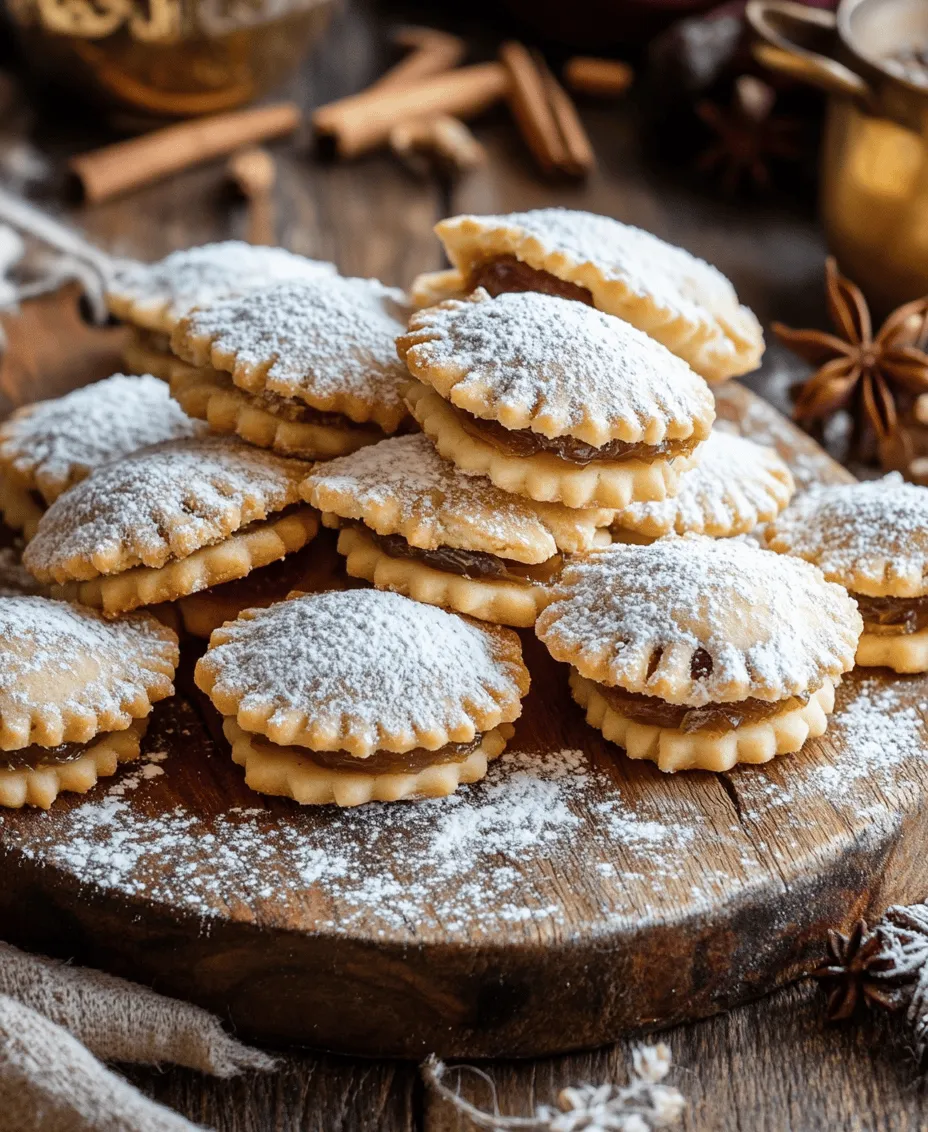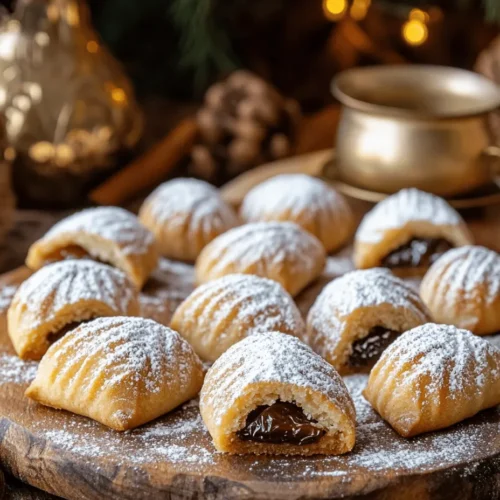Introduction
In the world of Middle Eastern desserts, few treats are as beloved as Maamoul, the delightful date-filled cookies that bring warmth and joy to any gathering. These cookies, often prepared during festive occasions such as Eid, Easter, and weddings, are not only delicious but also rich in tradition and history. Maamoul has stood the test of time, delighting generations with its unique blend of flavors and textures. The distinctive combination of a crumbly, buttery dough encasing a sweet, spiced date filling makes these cookies an irresistible treat for anyone who tries them.
Crafting Maamoul is more than just a baking project; it’s a culinary journey that connects you to the deep-rooted traditions of the Middle East. As you prepare to embark on this adventure, you’ll discover the importance of selecting high-quality ingredients, mastering the techniques that define these cookies, and understanding the cultural significance behind each bite. This article will guide you through crafting your very own batch of Maamoul, exploring the ingredients, techniques, and cultural significance behind these sweet gems. From the perfect dough to the luscious date filling, you’ll learn everything you need to create a memorable baking experience.
Understanding Maamoul: A Cultural Delight
Exploring the Origins of Maamoul
Maamoul has a rich and fascinating history that dates back centuries. The origins of these delightful cookies are believed to be rooted in ancient civilizations, where they were prepared as a special treat for celebrations and important events. The word “Maamoul” itself is derived from the Arabic verb “to knead,” referring to the process of preparing the dough. Traditionally, these cookies were made during the harvest season when dates were plentiful, allowing families to create delicious fillings that would be enjoyed by all.
The preparation of Maamoul is often a communal activity, bringing families together as they gather to share recipes and stories while kneading the dough and filling the cookies. This sense of community and tradition is what makes Maamoul so special. Each family may have its own unique recipe, passed down through generations, adding to the rich tapestry of flavors and techniques associated with this beloved treat.
Delving into the Historical Significance
Maamoul is not just a delicious dessert; it carries deep historical significance. In many Middle Eastern cultures, these cookies symbolize hospitality and generosity. Offering Maamoul to guests is a way of expressing warmth and welcome, reflecting the values of sharing and community that are central to these cultures.
Throughout history, Maamoul has been associated with various religious and cultural celebrations. In Christian communities, they are often made during Easter to celebrate the resurrection of Jesus, while in Islamic communities, they are a staple during Eid al-Fitr, marking the end of Ramadan. The act of baking and sharing Maamoul during these festive occasions reinforces familial bonds and cultural identity, making these cookies much more than mere sweets.
Maamoul in Different Cultures: Variations and Adaptations
While Maamoul is enjoyed across the Middle East, each region has its own unique spin on this classic treat. In Lebanon, the cookies are typically filled with a mixture of dates, nuts, and spices, while in Syria, variations may include a blend of crushed pistachios or walnuts added to the filling. In some regions, you might find Maamoul flavored with fragrant orange blossom or rose water, enhancing the aromatic qualities of the cookies.
In addition to the variations in filling, the dough used to create Maamoul can differ as well. In some recipes, semolina is the primary ingredient, lending the cookies a slightly coarse texture and a rich flavor. In other regions, all-purpose flour is used, resulting in a softer, more delicate cookie. This adaptability allows for countless variations, ensuring that Maamoul remains a beloved treat throughout the Middle Eastern world and beyond.
Ingredients Breakdown
The Essential Components of Maamoul
Creating the perfect Maamoul begins with understanding the key ingredients that contribute to its unique flavor and texture. The essential components of Maamoul include:
1. Dough Ingredients: The dough is typically made from semolina or all-purpose flour, combined with butter or ghee, sugar, and a hint of salt. This combination creates a rich, crumbly texture that is both satisfying and delicious.
2. Filling Ingredients: The filling is usually made from dates, which are naturally sweet and provide a rich, caramel-like flavor. Often, spices such as cinnamon, nutmeg, or cardamom are added to enhance the flavor profile. In addition to dates, nuts can be included for added crunch and depth.
3. Optional Add-ins: For those looking to add a unique twist to their Maamoul, consider incorporating ingredients like orange zest, rose water, or even chocolate. These additions can elevate the classic recipe, making your Maamoul stand out during festive gatherings.
Exploring the Dough Ingredients
The dough for Maamoul is crucial to the overall taste and texture of the cookies. Here’s a closer look at the primary ingredients used to create the perfect dough:
– Flour: Depending on the recipe, either semolina or all-purpose flour is used. Semolina gives the cookies a slightly grainy texture, whereas all-purpose flour results in a smoother dough. Some recipes even combine both for the best of both worlds.
– Fat: Butter or ghee is essential for achieving the rich, buttery flavor that Maamoul is known for. Ghee, a clarified butter, provides a deeper flavor and a slightly different texture. Whichever fat you choose, ensure it is at room temperature for easy incorporation into the dough.
– Sugar: A small amount of sugar is added to the dough to enhance its sweetness and flavor. It’s important not to overdo it, as the filling will contribute a significant amount of sweetness.
– Salt: A pinch of salt is necessary to balance the flavors, enhancing the overall taste of the cookies.
Understanding the Filling Ingredients
The filling is where the magic happens in Maamoul. The primary ingredient is, of course, dates. Here’s what you need to know about creating the perfect filling:
– Dates: Choose high-quality, fresh dates for the best flavor. Medjool dates are a popular choice due to their natural sweetness and soft texture, making them easy to work with.
– Spices: Ground spices add depth of flavor to the filling. Common spices include cinnamon, which adds warmth, and nutmeg or cardamom for a hint of aromatic spice. Feel free to experiment with your favorite spices to create a unique flavor profile.
– Nuts: Adding nuts such as walnuts or pistachios to the filling not only enhances the flavor but also adds a delightful crunch. Chop them finely and mix them with the dates and spices for a well-rounded filling.
Optional Add-ins for a Unique Twist
While traditional Maamoul is delightful on its own, there are many ways to customize your cookies to suit your personal taste. Here are a few optional add-ins to consider:
– Citrus Zest: A hint of orange or lemon zest can brighten the flavors of the filling and dough, adding a refreshing note.
– Flavored Extracts: A few drops of rose water or orange blossom water can elevate the aroma of your Maamoul, adding a fragrant touch that is characteristic of Middle Eastern desserts.
– Chocolate: For chocolate lovers, incorporating cocoa powder into the dough or adding chocolate chips to the filling can create a decadent twist on the classic recipe.
Preparation Steps for Maamoul Cookies
Preparing the Filling: A Step-by-Step Guide
The first step in your Maamoul-making journey is preparing the filling. Here’s a simple guide to get you started:
1. Select Your Dates: Choose high-quality dates, ensuring they are soft and fresh. Remove the pits and chop them roughly.
2. Blend the Ingredients: In a mixing bowl, combine the chopped dates with your chosen spices and finely chopped nuts. If the mixture is too dry, consider adding a small amount of warm water or a bit of honey to help bind it together.
3. Form the Filling: Once the mixture is well combined, use your hands to form small balls or logs, about the size of a walnut. Set these aside while you prepare the dough.
Creating the Dough: Techniques for the Perfect Texture
With the filling prepped, it’s time to create the dough. Follow these steps:
1. Combine Dry Ingredients: In a large mixing bowl, whisk together your flour, semolina, and salt. This ensures even distribution of the ingredients.
2. Incorporate the Fat: Add the room temperature butter or ghee to the flour mixture. Using your fingers, rub the fat into the flour until it resembles coarse crumbs. This step is crucial for achieving a crumbly texture.
3. Add Sugar and Liquid: Once the fat is incorporated, mix in the sugar. Gradually add water or milk (if needed) to bring the dough together. You want a soft, pliable dough that is not too sticky.
4. Knead the Dough: Lightly knead the dough on a floured surface until it is smooth and well combined. Be careful not to over-knead, as this can make the dough tough.
Binding the Dough: Achieving the Right Consistency
The key to perfect Maamoul lies in the consistency of the dough. Here are tips to ensure you get it just right:
– Test the Texture: The dough should be soft and slightly tacky but not sticky. If it’s too dry, add a little more liquid; if it’s too wet, add a bit more flour.
– Resting the Dough: Once the dough is ready, wrap it in plastic wrap and let it rest for about 30 minutes. This resting period helps the gluten relax, making the dough easier to work with.
Shaping the Cookies: Traditional vs. Modern Methods
Shaping the cookies is where you can get creative. Traditional Maamoul is often shaped using special wooden molds, but you can also use your hands or cookie cutters. Here’s how to shape your cookies:
1. Using Molds: If you have a Maamoul mold, take a small piece of dough and press it into the mold, creating an indentation for the filling. Place a portion of the filling in the center, then cover it with more dough, pressing gently to seal.
2. Hand-Shaping: If you don’t have molds, you can create round or oval cookies by flattening a piece of dough in your palm, placing the filling in the center, and folding the dough over to seal it.
3. Modern Methods: Alternatively, you can use cookie cutters to create fun shapes. Just ensure the thickness of the dough is uniform for even baking.
With the cookies shaped and ready to go, you’ll be well on your way to enjoying the delightful flavors of Maamoul. Stay tuned for the next part of the article, which will cover baking, decorating, and serving these delightful date-filled cookies.

Baking Perfect Maamoul
Preheating the Oven: Setting the Right Temperature
To achieve the perfect texture and flavor in your Maamoul cookies, preheating your oven is crucial. Set your oven temperature to 350°F (175°C). This temperature allows the cookies to bake evenly, ensuring a soft yet slightly crisp exterior while keeping the center tender. Before you start preparing your cookie dough, make sure to give your oven at least 15-20 minutes to reach the desired temperature. A properly preheated oven will help the cookies rise beautifully and maintain their shape.
Baking Techniques for Optimal Results
When it comes to baking Maamoul, the technique plays a vital role in achieving the desired outcome. Here are some essential tips for optimal baking results:
1. Use Parchment Paper: Line your baking sheets with parchment paper. This prevents the cookies from sticking and ensures even baking.
2. Cookie Size Consistency: Use a cookie scoop or measuring spoon to ensure uniformity in size. This helps all your cookies bake at the same rate and ensures even texture.
3. Spacing: Leave enough space between each cookie on the baking sheet. This gives them room to spread without touching each other, promoting even baking.
4. Rotate the Baking Sheet: For even baking, consider rotating the baking sheet halfway through the baking time. This is particularly important if your oven has hot spots.
Recognizing When Your Cookies Are Done
Maamoul cookies typically take about 15-20 minutes to bake. However, the exact time may vary depending on your oven. Keep an eye on the cookies as they bake. They should be lightly golden on the edges while still appearing slightly soft in the center. A good rule of thumb is to remove them from the oven as soon as you notice a hint of color on the underside. They will continue to firm up as they cool on the baking sheet.
Finishing Touches
Cooling the Cookies: Ensuring the Right Texture
Once your Maamoul cookies are out of the oven, it’s essential to let them cool properly. Place the cookies on a wire rack to cool completely. This allows air to circulate around them, preventing moisture buildup, which can lead to sogginess. Cooling also allows the flavors to develop and the texture to settle, ensuring the best possible eating experience. Generally, letting them cool for about 20-30 minutes is ideal.
The Art of Dusting: Adding Powdered Sugar
A classic finishing touch for Maamoul cookies is a generous dusting of powdered sugar. This not only adds a beautiful aesthetic but also enhances the sweetness of the cookies. Once fully cooled, use a fine sieve to sprinkle powdered sugar over the cookies. Be generous, but also mindful not to overdo it, as you want the sweetness to complement the rich flavor of the dates without overpowering it. For an elegant presentation, consider dusting the cookies just before serving to maintain the sugar’s brightness.
Presentation Ideas for Serving Maamoul
When it comes to serving Maamoul, presentation can elevate the experience. Here are some creative ideas:
– Platter Presentation: Arrange the cookies on a decorative platter, garnished with whole dates or nuts for a rustic touch.
– Tiered Cake Stand: Use a tiered cake stand for a more formal event. Layer the cookies for a beautiful display that invites guests to indulge.
– Accompanied by Tea or Coffee: Serve your cookies alongside a pot of Arabic coffee or mint tea. This not only complements the flavors but also enhances the cultural experience.
– Gift Packaging: If you’re giving Maamoul as gifts, consider placing them in clear bags tied with ribbon or in decorative boxes for a thoughtful presentation.
Pairing Suggestions
Beverage Pairings: What to Serve with Maamoul
To enhance your Maamoul experience, consider pairing these delightful cookies with beverages that complement their rich flavors. Here are a few suggestions:
– Mint Tea: A classic pairing, mint tea offers a refreshing contrast to the sweetness of the cookies. Its herbal notes balance the richness of the date filling.
– Arabic Coffee: The bold flavors of Arabic coffee harmonize beautifully with the sweetness of Maamoul, making it a traditional and popular choice.
– Spiced Chai: For a cozy twist, serve Maamoul with a cup of spiced chai. The warm spices will elevate the experience, making it perfect for gatherings.
Complementary Flavors: Enhancing the Experience
To further enhance your Maamoul cookies, consider incorporating complementary flavors that pair well with dates and nuts. Here are a few ideas:
– Nuts: Serve your cookies with a side of roasted almonds or walnuts. The crunchiness of the nuts adds texture and a pleasing contrast.
– Dried Fruits: Including dried apricots or figs can enhance the natural sweetness of the dates, creating a delightful medley of flavors.
– Cheese: A mild cheese like cream cheese or goat cheese can provide a creamy element that balances the sweetness, offering a more complex flavor experience.
Nutritional Insights
Caloric Breakdown of Maamoul Cookies
Understanding the nutritional content of your Maamoul cookies can help you enjoy them in moderation. On average, a single Maamoul cookie contains approximately 100-130 calories, depending on the size and specific ingredients used. The calories primarily come from the flour, butter, and date filling. While they are a delightful treat, being mindful of portion sizes can help you enjoy them without overindulging.
Healthier Alternatives and Ingredient Substitutions
For those looking to create a healthier version of Maamoul, consider these substitutions:
– Whole Wheat Flour: Swap all-purpose flour for whole wheat flour to increase fiber content and add a nutty flavor.
– Reduced Sugar: You can reduce the amount of sugar in the dough or use natural sweeteners like honey or agave nectar.
– Nut Butter: Instead of butter, consider using nut butters like almond or cashew butter for a healthier fat source that also adds flavor.
– Dates as Sweetener: For the filling, you can blend dates with nuts to create a more wholesome filling, reducing the need for added sugars.
Understanding the Nutritional Value of Dates
Dates are not only delicious but also packed with nutritional benefits. They are high in natural sugars, making them a great energy source. Additionally, dates are rich in fiber, which aids digestion, and contain essential minerals such as potassium, magnesium, and copper. They also provide antioxidants, which can help protect your body against oxidative stress. Incorporating dates into your diet can be beneficial, especially when enjoyed in moderation as part of a balanced diet.
Conclusion
Maamoul cookies are not just a delightful treat; they are a connection to cultural heritage and family traditions. As you embark on this baking journey, you’ll not only create a delectable dessert but also experience a slice of history with every bite. Whether enjoyed during special occasions or as an everyday indulgence, these cookies bring people together, making them a cherished addition to any kitchen. Enjoy the process of making Maamoul, and savor the delightful flavors that come from this timeless recipe. Each batch not only offers a taste of sweet indulgence but also weaves a story of tradition, warmth, and community. So gather your ingredients, share the experience with loved ones, and relish in the joy that Maamoul brings to your table.



